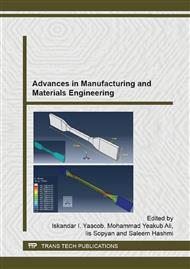p.433
p.440
p.446
p.450
p.454
p.458
p.462
p.468
p.472
Development of a Shape Memory Alloy (SMA) Based Assistive Hand
Abstract:
In Malaysia, every year approximately 40000 people suffer from stroke and many of them become immobilized as an after effect. Rehabilitation robotics to assist disabled people has drawn significant attention by the researchers recently. This project also aims to contribute to this field. This paper presents a Shape Memory Alloy (SMA) actuated wearable assistive robotic hand for grasping. The proposed design is compact and sufficiently light to be used as an assistive hand. It is a joint less structure, has the potential because the human skeleton and joint replace the robot’s conventional structure. This design has been implemented on index and thumb fingers to enable grasping. Shape memory alloy springs and bias force mechanism are used for purpose of hand’s flexion and extension. This paper describes the mechatronic design of the wearable hand, experimental study of actuation unit and sensory system. Open loop experiments are conducted to understand the hand characterization and grip force provided by index finger. Current, temperature, extension and contraction of shape memory alloy springs are reported. This mechanism requires approximately 2A current for the SMA to actuate which provides maximum of 1.6N of gripping force. Conducted experiments show promising results that encourage further developments.
Info:
Periodical:
Pages:
454-457
Citation:
Online since:
July 2015
Keywords:
Price:
Сopyright:
© 2015 Trans Tech Publications Ltd. All Rights Reserved
Share:
Citation:


